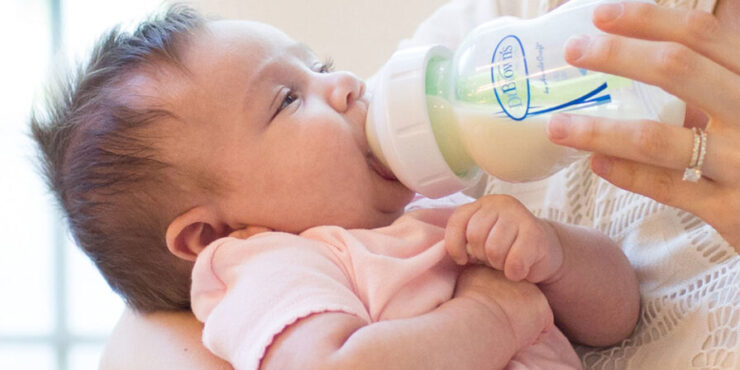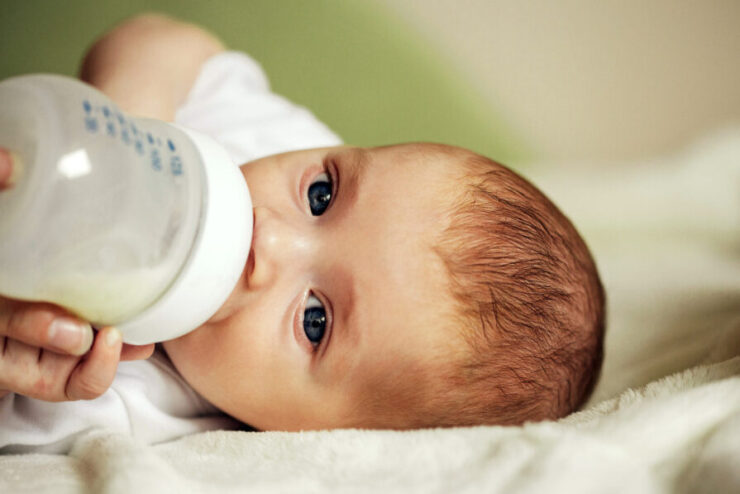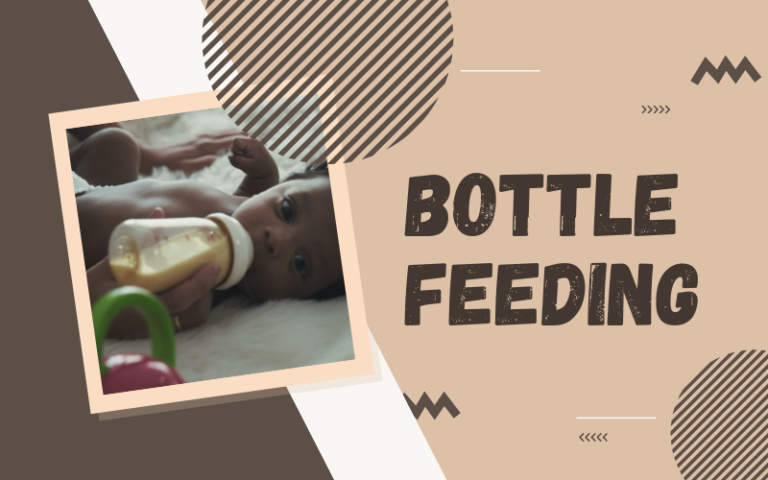Usually, most newborn babies have no problems in sucking from the bottle’s nipple. That’s a huge relief for the parents who are feeding an infant from the bottle right from the start. Newborn babies take about two ounces in each feeding from the bottle. This amount goes up gradually with time.
If you are planning to do just bottle feeding, it is best that you start immediately after birth. However, if you are feeding on the breasts, then it’s best to wait for a couple of weeks before you start with a bottle. Introducing a bottle earlier might interfere with breastfeeding. After all, your breasts are not adequately stimulated for pumping the milk supply. But don’t delay for more than 2-3 weeks. Your infant may become too accustomed to your breasts and might reject the bottle as this will be unfamiliar to her. Do not allow her to become used to the breasts.
Infant Bottle Feeding

A great advantage of feeding from a bottle is that, anyone in the family can do it. This is always great help for the mom. She has carried the baby for so long within her and certainly needs a break. She might also be a working woman who has to return to work again. She can return to her pre-delivery schedule if a dad or even a sibling can take the responsibility of feeding the infant by using a bottle.
However, when a bottle is first introduced, remember, some babies will need some practice, while others take it naturally. Also, be careful if you are thinking of feeding formula food. There are all types of formula products out there. Holle Formula from The Milky Box is a good bet, trusted by many parents for their infants. This formula food will provide the infant with adequate nutrition for growth.
Bottle feeding help for you –
Bottle-Feeding – What to Do

- Use the nipple’s tip or finger to stroke the baby’s cheek. She will know that milk is available. The infant will be encouraged to turn towards the right direction. Now, place the bottle between her lips gently. She will start sucking. If she doesn’t suck still, then apply a drop on the lips.
- Make sure that you tilt the bottle completely so the liquid will fill the nipple. Air will fill it up if the tilting is not done completely. The infant will drink the formula together with the air, which can cause gas. You can minimize gas by using an angled bottle. This will keep the food close to the nipple. You may keep her in the arms as well and not lying horizontally. This should also help because the horizontal position can make the milk go into her middle ear, which is not good naturally.
- Look out for signs of whether the infant has taken adequate food. Often, they cannot drink the entire bottle. In case she goes to sleep once she has consumed more than half, then she possibly has taken enough. It could be a sign of gas if she is turning away after only little sucking. Burp her in such a situation and then introduce a bottle. She must be full if she denies again. Don’t force.
- Make sure to use a good nipple, right for the baby. If she makes sputtering or gulping sounds while feeding and if you see the milk dribbling from her mouth’s corners, then it’s a sign which will tell you that its flowing too fast. On the other hand, if you see her working too hard, then the food flow isn’t good enough, probably. Make the cap slightly loose or replace the nipple.
- Work on bonding. When you are bottle-feeding, you have the opportunity to strengthen the bond with the child, just like what happens while breastfeeding. Sing, talk to her, make eye contact, cuddle.
Bottle-Feeding – Here’s What to Avoid

- Never use the microwave for warming bottles. Microwaving technology always heat them unevenly. There may be hot spots, which may burn her mouth. Placing a bottle below hot water is always best. You may use a bottle warmer as well. If the child likes cold drink, then you might also decide not to warm at all. However, do remember to shake your bottle well before feeding. Also, check the temperature. Pour a few drops of the liquid on wrist. Best, you should serve lukewarm liquid.
- Never place your infant on the bed with her bottle. This can cause choking, tooth decay, even ear infections.
- Never mix cereal with breast milk, formula food. Some people are of the opinion that doing this helps a baby have sound sleep. But you must always speak to the doctor before doing this. The fact is, cereal cannot help infants sleep better during the night. In fact, many babies cannot swallow them easily. Plus, you might be providing excess pounds by serving cereals at an early stage.
- Choose the formula carefully. There’s a lot of science behind these products. You must read the preparation directions carefully. Each formula may need powder and liquid in different ratios. A lot of water can be dangerous because this can bring down the blood salt to dangerously low levels, which can cause seizures. Very little water can cause dehydration. So be careful about the volume of water you add.
There are sometimes problems with bottle feeding. Don’t worry because they can be solved easily. The infant may refuse her bottle, can become allergic to the milk or may have other problems. You can solve them easily with help from a doctor.
The Right Quantity of Milk for Baby

Always start slowly. In the 1st week, she shouldn’t consume more than one to two ounces in each feeding. Give her food on-demand or once every three, four hours. Increase this gradually as she grows. However, remember not to push her ever. Follow this rule even if you are combining breast milk with formula. Follow this for pumped milk that is stored in a bottle as well. Never force her to finish the amount you have served.
Also, choose the bottle and the nipple carefully. Read reviews, ask for recommendations. Carry out some research. Some infants like certain nipples and bottles. So the first one you select may not be the best for your child. Be open to experimenting. The others are not picky.

